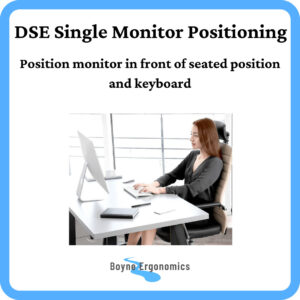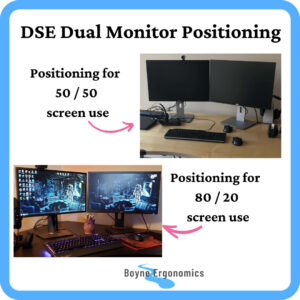Screens and monitors are such a huge part of the day for many people, both in education, work and leisure. Poor monitor positioning, glare and inappropriate settings can increase the risk of musculoskeletal discomfort, eye strain, fatigue and headaches.
In this blog post I am going to highlight how best to position and adjust your monitors, based on how you use them, to help keep you healthy and well.

Monitor Placement
A common issue that can arise during virtual and in-person DSE assessments is incorrect monitor placement. When we talk about monitors, these include laptop monitors and tablets, as well as the standard external computer monitors. I would also consider phone screen positioning if it is used frequently during the work day.
But, why does it matter?
Inappropriate monitor positioning and settings can encourage adverse postures of the neck, shoulders and back, can increase the risk of eye strain and eye fatigue and can increase the risk of headaches and migraines.
If the screen is too low it will encourage head down, slouching or rounded shoulder postures. If the screen is too high it will encourage repetitive neck extension. If it is too far from you it will be difficult to read and will encourage forward leaning. If it is too close it can cause eye strain and fatigue.
There are different ways to place your monitors based on how many you have, how you use them and your visual requirements.
As a rule of thumb, the monitor should be approximately an arm length from your seated position when you are seated upright with your back against the backrest of the chair. To assess if your screen is the correct distance from you, sit in your usual typing position and extend the arm out in front of you. The screen should be at the end of your fingers. If you have difficulty reading the text on the screen at this position when you sit with your back in contact with the backrest, you can increase the size of the image, you may need to upgrade to a larger monitor and you may need to visit your optician if it has been 2+ years since your last eye test.
Reducing Glare and Reflections
To reduce the risk of glare and reflections, ideally the monitor should be positioned at a right angle to the window or natural light source.
If this is not possible, position the natural light behind the monitor, using adjustable blinds or curtains to eliminate any direct sunlight. Try to avoid having your natural light source facing the monitor.
If you experience glare from overhead lighting, adjust the tilt angle or move the position of the workstation to reduce the glare.
If you are unsure if you have glare on your screen, sit in your usual position and turn the screen off. Glare will show on the dark screen.

Monitor Height
For users that do not wear corrective lenses, or wear single vision lenses, the screen should be high enough that when you are seated upright, with your back against the backrest of the chair and looking straight ahead with a relaxed neutral neck, your eyeline rests on the top third of the screen. The internet address bar is a good guide. This applies to laptops, monitors and tablets.
Remember, set your seated height first and then set your monitor height. If you use a sit stand workstation, you should not have to adjust the monitor height when you change positions.
However, if you wear varifocal / bifocal glasses, you may need to position the screen lower than your resting eyeline and tilt the top of the screen backwards so you can see the screen through the lower part of your lenses and reduce adverse neck postures.

Positioning a Single Monitor
The screen, be it laptop or external monitor, should be positioned directly in front of your seated position and the keyboard. This will help keep you optimally aligned, keeping the ear over the shoulder over the hip.

Positioning Dual Monitors
The placement of dual monitors varies based on how you use them.
If you use one monitor as a main monitor and one as a secondary holding monitor, for emails or reference documents (80/20 use) position one monitor directly in front of your seated position. The second monitor should be positioned next to this main monitor and turned in towards the seated position to reduce repetitive neck postures.
If you use both monitors equally (50/50 use) position both monitors side by side and angled inwards. Your seated position should be in between both screens. This will reduce repetitive neck postures.

Positioning Three Monitors
If using three screens at the workstation, place your main screen in front of your seated position. Place you two additional screens on either side of this central screen and turn them in toward your seated position.
Remember, the monitors should be set up so you can see the most amount of the screen with the minimum repetitive neck movements. Correct positioning and settings will reduce adverse postures and repetitive movements, thus reducing the risk of developing musculoskeletal discomfort and the risk of eye strain, fatigue and headaches.
Ideal Monitor Settings
Eye discomfort is a common complaint among DSE users, with symptoms including dry, red & itchy eyes, sore eyes, headaches and a lack of concentration.
Ensuring your screen settings are optimised for the work environment can do a lot to reduce the workload on the eyes and reduce discomfort, specifically the contrast, brightness and hue settings.
Let’s look at contrast first. Contrast is “the ratio of luminance between the brightest white that can be produced and the darkest black that can be produced” i.e. how the text stands out from the background. Contrast levels that are too low or high can increase the risk of eye fatigue. Usually, on mobile devices, the contrast level is set on the device and cannot be adjusted. If you are using an external monitor, contrast levels can usually be adjusted by pressing the menu / settings button on the screen and navigating to the contrast option. The recommended level is between 65% – 70%.
Next, we have screen brightness. The appropriate brightness level of your screen is related to the light level in your work area. As light level changes in the work area, so too should your screen brightness level. The brightness level should match your environment. If your screen brightness is too high, the more blue light emitted but if the screen is too dull it will be difficult to see images and text and both settings can increase the risk of eye strain, fatigue and headaches.
For the standard office lighting levels, a brightness setting of 60 is usually sufficient. Office light levels are usually stable during the work day and so brightness levels are not adjusted during the day. If you are working from home, a brightness level of 40 may be more appropriate but it depends on light levels. The lower the light levels, the lower the brightness setting should be.
If you are experiencing eye strain, fatigue or headaches I recommend reducing the brightness setting on your monitor to see if this reduces symptoms.
Another setting you can adjust is the colour temperature, or hue. Ideally the colour hue should be cooler in bright work areas and warmer in darker work areas. Cool tones (around 6500K) are the standard monitor settings. On some devices, hue can be changed from cool to warm by turning on Night Mode, which will reduce the blue light emitted and change the monitor colour to a warmer, yellow hue (around 3,400K). There are apps available that can automatically adjust the hue of the monitor during the day. I use F.lux on my laptop for this purpose.
Eye Rest Breaks
As with all DSE equipment, positioning and settings are only part of the risk. Looking at the screen for prolonged periods without taking rest breaks will increase the strain and fatigue on the eyes. The eye muscles holding the lens in place get tired and the rate of blinking reduces as we concentrate, increasing the risk of dry, irritated eyes.
It is recommended that DSE users follow what is known as the 20-20-20 rule. This advises that users look away from the screen at least every 20 minutes, at an object 20 feet away for 20 seconds. This allows time for the eye muscles to recover and the eyes to rehydrate.

It is advised to have an eye test every 2 years to monitor visual acuity and eye health. If you notice a deterioration in visual acuity, or any other issues with your eyes, arrange an eye test to assess action required.


